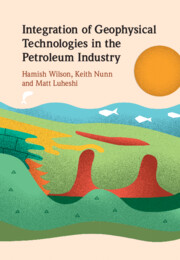Book contents
- Integration of Geophysical Technologies in the Petroleum Industry
- Integration of Geophysical Technologies in the Petroleum Industry
- Copyright page
- Contents
- Contributors
- 1 Introduction
- 2 The Hydrocarbon Exploration Process
- 3 Crustal Seismic Studies
- 4 Gravity and Magnetics
- 5 Full Tensor Gradiometry
- 6 Marine Electromagnetic Methods
- 7 Ocean Bottom Marine Seismic Methods
- 8 Microseismic Technology
- 9 A Road Map for Subsurface De-risking
- Glossary
- Index
- References
4 - Gravity and Magnetics
Published online by Cambridge University Press: 25 November 2021
- Integration of Geophysical Technologies in the Petroleum Industry
- Integration of Geophysical Technologies in the Petroleum Industry
- Copyright page
- Contents
- Contributors
- 1 Introduction
- 2 The Hydrocarbon Exploration Process
- 3 Crustal Seismic Studies
- 4 Gravity and Magnetics
- 5 Full Tensor Gradiometry
- 6 Marine Electromagnetic Methods
- 7 Ocean Bottom Marine Seismic Methods
- 8 Microseismic Technology
- 9 A Road Map for Subsurface De-risking
- Glossary
- Index
- References
Summary
The gravity and magnetic survey methods have been in use since the early days of geophysical prospecting for petroleum. They find most application in frontier exploration. In that context, regional and global datasets are often available to assist with early evaluations.
The design and execution of modern, targeted surveys has been transformed as a result of advances in instruments and the advent of satellite navigation. Imaging and interpretive techniques have been transformed by modern computer-based approaches. The potential field methods are extremely cost-effective at delineation of basins and determining structural controls on those basins, especially delineating normal faulting within rift basins. Magnetic surveys yield depth to basement and delineate any igneous rocks present. Such surveys therefore enable early decisions about cost-effective placement of seismic surveys and other intensive follow-ups.
In more mature exploration, gravity and gravity gradient data combine well with seismic data in distinguishing between alternate interpretations, thereby removing ambiguities. High-resolution magnetic data offer an effective means of fault connection in conjunction with regional seismic coverage, if shales or mudstones are present.
In a production environment, gravity logging is the most sensitive density log available, and 4D-gravity finds application in gas production and also water-flood monitoring.
Keywords
- Type
- Chapter
- Information
- Publisher: Cambridge University PressPrint publication year: 2021

